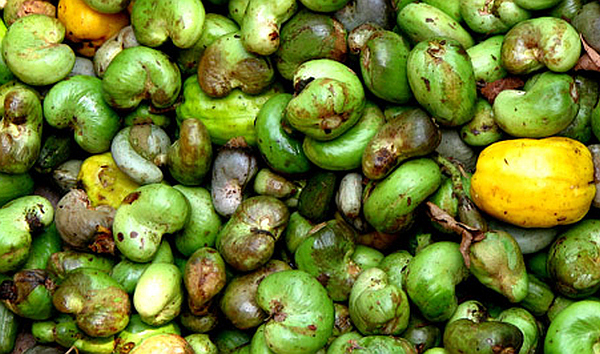 |
Leaves of three, let it be . . . Poison ivy is a common source of contact dermatitis. |
 |
Immature "berries", which turn deep red or purple when ripe, are actually drupes, containing one seed. |
While common throughout North America, poison ivy prefers "edge" settings -- where woods meet pasture land, for example -- or along roadways.
In highly urbanized settings like Plainfield, it is likely to pop up along fence lines and shrubs at the edges of gardens. Its seeds are spread by birds, who feast on the berries and are not bothered by urushiol, the substance so bothersome to humans.
So, would you be surprised to know there are actually two kissin' cousins of poison ivy with which you are probably very familiar and which you may actually eat on a more or less regular basis?
MANGOES
Immature Mango fruits and flopwers.
A Mango cup open, exposing its drupe.
Mangoes, once considered somewhat exotic in supermarkets are now commonplace (more here).
An enormously important commercial fruit originating in Asia, mangoes are the national fruit of India. Over the centuries they spread to suitable tropical areas in South Asia and Africa, coming finally to the New World, where they are grown throughout the Caribbean as well as <Mexico and Brazil.
Like other members of the Anacardiaciae, mangoes are drupes, with a hard-shelled seed encased in a fleshy fruit.
Also, like other members of this family, some individuals can get contact dermatitis from the leaves, stems, bark and skins of the fruit.
If you've never tried mango, you can find small packages of freshly cut up mango at Supremo supermarket in the apple and grape aisle. Kept on ice, they are an inexpensive, tasty and healthy snack.
CASHEWS
Cashew Apples, with drupes.
The drupes each contain a single "nut",
which must be roasted to destroy the toxins
that can cause contact dermatitis.
The result, a tasty and nutritious snack.
Another kissin' cousin of poison ivy is the cashew (more here). It is also a commercially valuable product, only in this case we in North America are most familiar with its drupe, which we refer to as the cashew "nut" (though it is really a seed).So, the next time you enjoy a handful of cashews or some mango slices, give a nod to their kissin' cousin, your old friend poison ivy.
In Latin America, however, the fleshy cashew "apple" is used to prepare a highly popular sweet drink. Cashew apples are thin-skinned and do not travel well, so don't expect to see them in you supermarket soon.
As with other anacards, cashews in their raw form can cause contact dermatitis. The oils at the root of the problem are destroyed by roasting the cashew drupes, each of which contains just one "nut".











0 comments:
Post a Comment